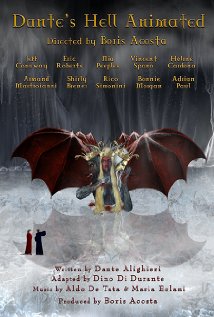This article needs additional citations for verification .(February 2016) |
| Dante's Hell Animated | |
|---|---|
 | |
| Directed by | Boris Acosta |
| Based on | Inferno by Dante Alighieri |
| Produced by | Boris Acosta |
| Starring | Eric Roberts Jeff Conaway Nia Peeples Vincent Spano Franco Nero Riccardo Pratesi Silvia Colloca Vittorio Matteucci Vittorio Gassman |
| Edited by | Angelo Acosta |
| Music by | Aldo De Tata |
Production company | Gotimna Productions |
| Distributed by | Global Film Sales |
Release date |
|
Running time | 39 minutes |
| Country | United States |
| Languages | English Italian |
Dante's Hell Animated is a 2013 American animated short film produced and directed by Boris Acosta. [1]
Contents
The story is based on the first part of Dante Alighieri's Divine Comedy – Inferno .